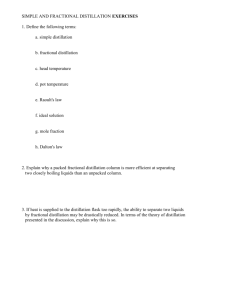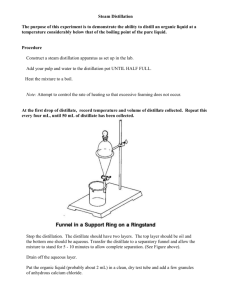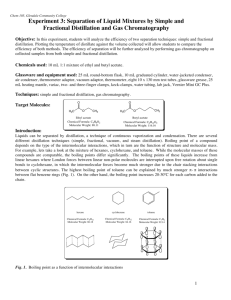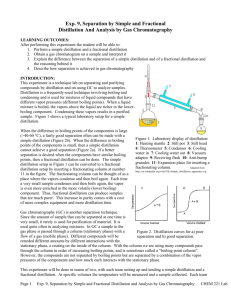Handout for Expt 3.8AB – Simple and Fractional Distillation This is a
advertisement
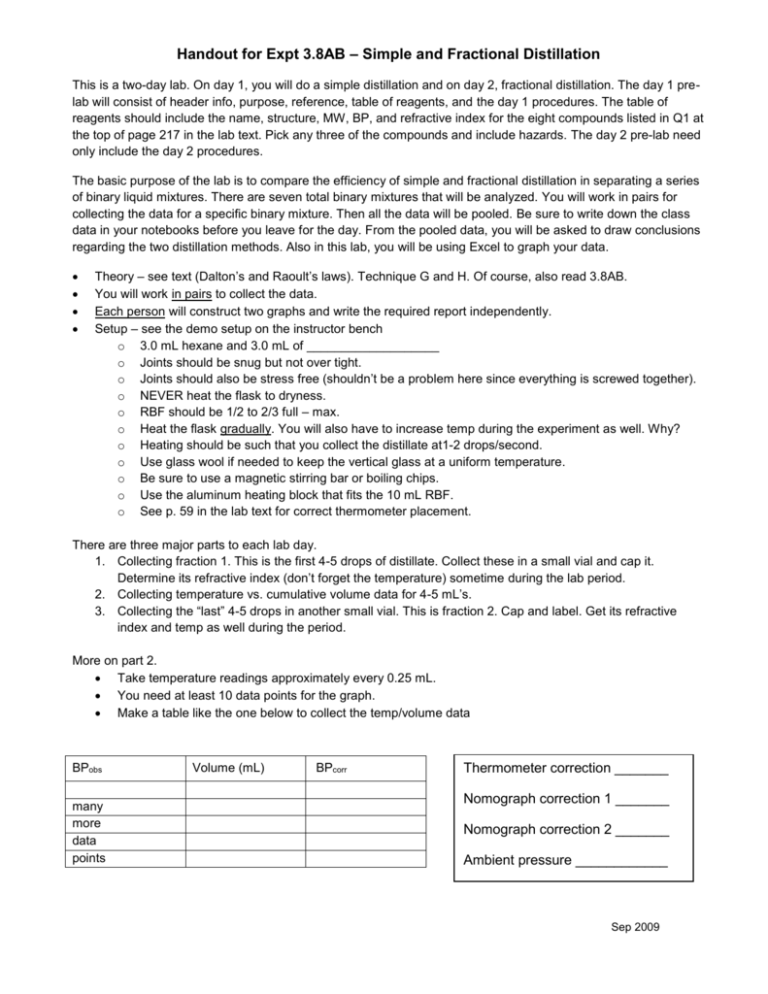
Handout for Expt 3.8AB – Simple and Fractional Distillation This is a two-day lab. On day 1, you will do a simple distillation and on day 2, fractional distillation. The day 1 prelab will consist of header info, purpose, reference, table of reagents, and the day 1 procedures. The table of reagents should include the name, structure, MW, BP, and refractive index for the eight compounds listed in Q1 at the top of page 217 in the lab text. Pick any three of the compounds and include hazards. The day 2 pre-lab need only include the day 2 procedures. The basic purpose of the lab is to compare the efficiency of simple and fractional distillation in separating a series of binary liquid mixtures. There are seven total binary mixtures that will be analyzed. You will work in pairs for collecting the data for a specific binary mixture. Then all the data will be pooled. Be sure to write down the class data in your notebooks before you leave for the day. From the pooled data, you will be asked to draw conclusions regarding the two distillation methods. Also in this lab, you will be using Excel to graph your data. Theory – see text (Dalton’s and Raoult’s laws). Technique G and H. Of course, also read 3.8AB. You will work in pairs to collect the data. Each person will construct two graphs and write the required report independently. Setup – see the demo setup on the instructor bench o 3.0 mL hexane and 3.0 mL of ___________________ o Joints should be snug but not over tight. o Joints should also be stress free (shouldn’t be a problem here since everything is screwed together). o NEVER heat the flask to dryness. o RBF should be 1/2 to 2/3 full – max. o Heat the flask gradually. You will also have to increase temp during the experiment as well. Why? o Heating should be such that you collect the distillate at1-2 drops/second. o Use glass wool if needed to keep the vertical glass at a uniform temperature. o Be sure to use a magnetic stirring bar or boiling chips. o Use the aluminum heating block that fits the 10 mL RBF. o See p. 59 in the lab text for correct thermometer placement. There are three major parts to each lab day. 1. Collecting fraction 1. This is the first 4-5 drops of distillate. Collect these in a small vial and cap it. Determine its refractive index (don’t forget the temperature) sometime during the lab period. 2. Collecting temperature vs. cumulative volume data for 4-5 mL’s. 3. Collecting the “last” 4-5 drops in another small vial. This is fraction 2. Cap and label. Get its refractive index and temp as well during the period. More on part 2. Take temperature readings approximately every 0.25 mL. You need at least 10 data points for the graph. Make a table like the one below to collect the temp/volume data BPobs many more data points Volume (mL) BPcorr Thermometer correction _______ Nomograph correction 1 _______ Nomograph correction 2 _______ Ambient pressure ____________ Sep 2009 The observed boiling point temperature and volume will be collect during the class. The corrected temp column can be done afterwards. Use a nomograph (p. 29) to get the delta T for the atmospheric correction for the initial and final BP’s. You will have to decide when to use which one if they are different. Use Excel to plot the BPcorr column against the volume. See p. 56 in your lab text. You can get help on using Excel in the SLC. Also follow the graphing guidelines provided. For parts 1 and 3: After you get the refractive index and temperature for both fractions, write these on the whiteboard so the rest of the class can copy your data. Be sure to copy the class data for all seven binary liquid mixtures in your notebooks before you leave. Absolutely no scratch paper allowed. Summary Day 1. Do the simple distillation. In pairs. Write your values for nD and the refractometer temperature on the board for fractions 1 and 2 for your binary mixture. Copy the values for the other binary mixtures into your notebook before you leave. Do the calculations for the corrected temperature column if time permits. Start work on the graph. It is due at the start of day 2. Standard deductions if late. Chart type is “Scatter with smooth lines and markers”. You do not need a legend since there is only one series. Do not add a trend line or equations. Follow the general graphing guidelines provided. Day 2. Turn in the graph for the simple distillation. Do the fractional distillation- again in pairs – same binary liquid. You will get the first graph back with comments. Be sure you have it when you leave. Again write your data on the board and copy the data for the other binary mixtures. Due date for the report is still TBD. You will write title, abstract, and results/discussion sections covering both simple and fractional distillations. Follow the report guidelines provided. Three pages max. The report should contain a single Excel graph (imbedded in the results) showing both simple and fractional distillation curves. Use different markers for each curve. The chart type is “Scatter with smooth lines and markers”. You should have a legend this time. No trend lines or equations. Follow the general graphing guidelines provided. Since the final graph is part of the report, your name, section, etc., does not need to be part of the graph. NOTE: each person will do their own graph and report. Copied graphs and/or reports will result in zeros for both parties. There is also the possibility of dismissal from the course with a failing grade for flagrant violations. Notebook pages for both parts should be stapled together and paper clipped to the back of the report. Since this report covers two labs, it will be worth 100 points. There is no datasheet. Some ideas for focusing your thoughts and conclusions will be provided next lesson. Sep 2009


